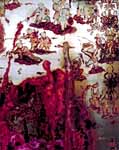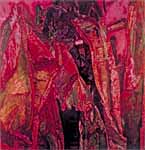|
Blood-red paint oozes
across the canvas, contorting and congealing. In the
corner of the room, a bathtub is stained fuchsia. Thick
sanguine clots mar pristine satin ladies' pumps. Menstrual-red
oil paint covers a row of bicycle seats and drips onto
the floor. As if watching the climax of a horror movie,
the viewer is drawn irresistibly into the scene with
both terror and fascination.
Meeting the artist of
Off the Canvas and Beauty Banana Series, a solo exhibition
at the Courtyard Gallery, which runs until Tuesday,
January 18, only adds to the already disorienting experience.
Nothing in the provocative boldness of her work prepares
you for 34 year-old Cai Jin's calm nature. Unobtrusively
descending the stairs, a shy, elfish figure in plain
gray enters the room. Severe bangs frame her youthful
face. Her eyes beam, almost childlike. Her voice is
soft and precise as if every word is carefully prepared.

Drawn toward abstract
expressionism as an art student, the New York-based
Cai developed a uniquely powerful impasto brushwork
technique. With it, she began depicting curves of the
human shape, stringed musical instruments and more abstract
forms. Soon she gained international recognition through
an underlying, near-obsessive fascination with the banana
plant, a single theme which she traces back to her native
Anhui province in southern China.
Cai Jin, who started
the Banana series in the early 1990s, explains how she
was first inspired nine years ago when she came across
a withered banana plant while walking through a field.
The huge leaves enclosed
the blood-red pod of the banana plant. The original
green of the plant had long faded. The shape and color
of this withered tree completely transfixed me. It was
a strange and inexpressible sensation, she says.
The contorted shapes
of these wilting banana plants are what lend Jin's paintings
their depth and lure. Shriveled leaves mutate into a
decomposing crimson pulp that spreads and transforms
itself across the canvas. The result is something like
raw flesh, an almost visceral collage that, despite
its state of decomposition, seems sensual and alive.
It resembles an open wound that has not quite healed,
yet breathes with the vitality of birth.
Cai Jin's captivation
with the dying plant as something diseased and decaying,
yet pulsating and alive was to become a consistent theme.
Somehow it seemed that inside the tree inside its trunk
and leaves everything was still breathing. After a few
days I was still completely enveloped in the atmosphere
of that plant. As my brush moved automatically across
the canvas, I experienced a great feeling of pleasure,
as though I were painting something that I had painted
before.
When talking about her
work, Cai constantly refers back to her early childhood,
her face lighting up with each memory. Those years spent
growing up in a small village in southern Anhui would
later influence much of the color and form in her work.
In the South, the houses
are very old and the walls are white. But because it
rains so much, mold would grow and form patterns. These
stains had a lasting impression on me, she says.
Those mildew patterns
reappear as blue and green speckles in her paintings,
weaving through worm-like funnels of pink and red. Also,
Cai's memories of wooden, latticed windows and doors
that framed her childhood house return as intricate,
geometric patterns in her sketches.
Recently Cai began experimenting
with painting on new media: cushions, mattresses and
sofas. Her trademark fuchsia is splashed like clotted
blood on the shiny, smooth surfaces of satin shoes,
a silk-covered sofa and black leather bicycle seats.
These objects bring Jin's paintings into the realm of
daily experience. The softness of their shapes suggest
the curves of the human body they serve. The red paint
sits, without fully blending with the surface itself,
suggesting stains left by human contact.
It is tempting to try
to draw conclusions and label the work as repulsively
raw, disturbingly violent, or overtly sexual. In a milder
interpretation, her paintings have been described as
distinctly feminine. Cai Jin, however, insists they're
all wrong.
I don't paint to cause
people fear and I don't want people to have the feeling
that my work is sexual. If I see something I think would
look good to paint, then I paint it, she says. I'm not
intentionally trying to be different from others. I
do everything completely by instinct.
Off the Canvas runs
until January 18 at the Courtyard Gallery, Donghuamen
Dajie, Dongcheng District, 9 am-5pm, free
|




